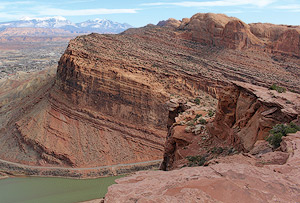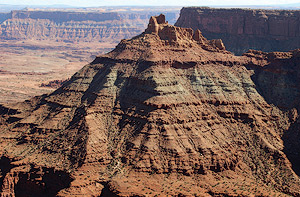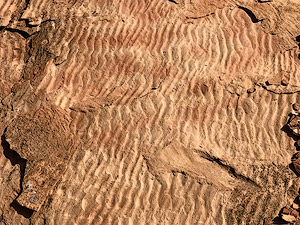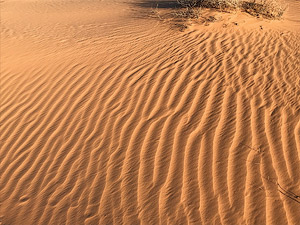 |
| Tilted rock layers on the Moab Rim. |
In the legal sense, the phrase laws of the land indicates all the valid laws that exist in a country. In human societies, laws codify the principles and values that people use to govern themselves.
Within the science of geology, the land itself governs the paths researchers take when trying to decipher the history of the Earth and understand the origins of its rocks, minerals, and fossils. Geology is in large part a historical science meaning that it determines sequences of past natural events and reconstructs histories by observing the available evidence. In this way, it is like paleontology, archeology, and parts of biology, astronomy, and physics. Geology is a particularly multifaceted science incorporating aspects of many different specialties and laboratory analysis in addition to fieldwork.
The primary purpose of all scientific endeavors is to not just accumulate facts (confirmed observations), but develop theories (explanations) about them. For example, the theory of plate tectonics explains many facts about the Earth’s surface: narrow volcanic mountain ranges occurring in places where two tectonic plates collide whereby one plate slides underneath the other (as in the Pacific Northwest), and large earthquakes (but no volcanoes) where one plate slides past another (the San Andreas Fault).
 |
| The layers at the bottom of this sequence of rocks are the oldest and the ones at the top are the youngest. |
Plate tectonics also helps explain the geologic history of southeastern Utah. Facts like the region’s overall high elevation are explained by plate motions that produced a complex collisional tectonic environment in the American west about 70 million years ago which uplifted this region.
In science, the term law has a specific meaning different from the legal one. A law (sometimes also termed a principle) is a description of some part of the natural world. Laws are generalizations based on the observation of facts and can be predictive about what will be observed when similar sets of facts are encountered. The law of gravity is an example of a well-known scientific law, in this case in the field of physics.
Several principles have guided geologists from it early days as a science through today when geologic investigative tools go far beyond than original ones of shoe leather and rock hammers. Even more broadly, anyone can apply these principles to observations of the canyon country landscape to gain an understanding of its geologic history.
 |
| Ripple marks in an ancient sandstone. |
The most fundamental principle in geology is uniformitarianism, which is paraphrased as the present is key to the past. Geologists use uniformitarianism to interpret features like ripple marks found in some sedimentary rocks. Observations of how sand ripples form today by either wind or water currents are used to interpret ripple marks in many rock layers (formations to geologists) found near Moab. The same types of extrapolations may be made for mud cracks, fossil footprints, and other rock features. Geologists use their knowledge of modern Earth environments to help determine the conditions under which ancient sedimentary rocks were deposited, such as in sand dunes or river channels.
The Law of Superposition is also important to understanding canyon country. This principle states that within a sequence of rock layers, the oldest layer is at the bottom and the youngest is at the top. This principle allows anyone standing on a canyon rim to know that the youngest rock in the sequence is immediately beneath their feet and that the rocks get progressively older toward the canyon bottom.
 |
| Modern ripples in sand. |
The Law of Original Horizontality says that sedimentary rocks are laid down in flat layers under the influence of gravity. If rock layers are tilted, as they are along the Moab Rim, something must have happened to them after deposition to deform them.
The Principle of Cross-Cutting Relationships states that any geologic feature that cuts across another feature must be the younger of the two.
It’s possible to use these principles together to figure out sequences of geologic events and to reconstruct geologic histories. For example, Grand Canyon contains a sequence of rocks where the layers at the bottom are
at an angle relative to layers on top. Uniformitarianism lets us use our understanding of the Earth today to interpret its past. Superposition means that the oldest rocks are at the bottom, original horizontality that the tilted layers were originally flat, and cross-cutting relationships means that the surface where the tilted layers meet the flat layers is younger than the event that tilted the bottom layers.
 |
| The angular unconformity in Grand Canyon. Photo by James St. John. |
The sequence of events at Grand Canyon is as follows (oldest to youngest) :
The rocks at the bottom were deposited in flat layers.
1- The bottom rock layers were tilted.
2- The tilted rock layers were eroded creating a nearly flat surface. (This type of surface caused by erosion is known as an angular unconformity. Unconformities represent missing time, and angular unconformities form when some sort of geologic event tilted older rocks before the deposition of younger ones.)
3- The rock layers above the unconformity were deposited with the youngest of these layers being the highest on the canyon wall.
4- In some ways, these geologic principles and laws are the application of common-sense problem-solving in the pursuit of understanding the planet’s history. But they remain as fundamental in geologic research as they ever have been.
|